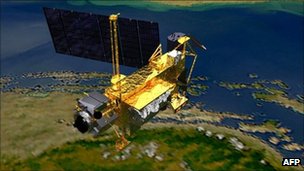
Nasa's UARS spacecraft fell to Earth north-east of the
Orbital tracking experts have now established that the defunct satellite entered the atmosphere over the
Nasa's UARS spacecraft fell to Earth north-east of the
Orbital tracking experts have now established that the defunct satellite entered the atmosphere over the
Any debris that survived Saturday's fiery descent would have plunged into open water, the
 The exact time the six-tonne craft engaged the atmosphere is now given as 0401 GMT.
The exact time the six-tonne craft engaged the atmosphere is now given as 0401 GMT.
The Upper Atmosphere Research Satellite (UARS) was the largest American space agency research platform to return uncontrolled from orbit in about 30 years.
Its fall from the sky generated huge interest worldwide at the weekend, with the possibility that its destruction would produce a spectacular fireball in the sky for anyone close enough to see it.
The return was monitored by the Joint Space Operations Center (JSPOC) at Vandenberg Air Force Base in
On Saturday, JSPOC's best estimate for the timing of the re-entry was 0416 GMT. Post-fall analysis has now brought that forward by 15 minutes, meaning the event occurred much further from the west coast of North America than was originally thought.
Modelling work had indicated perhaps 500kg of mangled metal could have survived to the surface, spread over a path some 800km long. If the latest analysis is correct, it seems certain all of that debris would have gone into the ocean.
"We have a high accuracy assessment based on a large number of data points, and we're very, very confident in our latest assessment," said Nick Johnson, Nasa's chief scientist for orbital debris at the
UARS was deployed in 1991 from the space shuttle Discovery on a mission to study the Earth's upper atmosphere.
It contributed important new understanding on subjects such as the chemistry of the protective ozone layer and the cooling effect volcanoes can exert on the global climate.
Tracking stations will typically witness the uncontrolled return of at least one piece of space debris every day; and on average, one intact defunct spacecraft or old rocket body will come back into the atmosphere every week.
Something the size of UARS is seen perhaps once a year. Much larger objects such as space station cargo ships return from orbit several times a year, but they are equipped with thrusters capable of guiding their dive into a remote part of the Southern Ocean.

 Previous page
Previous page Back to top
Back to top







